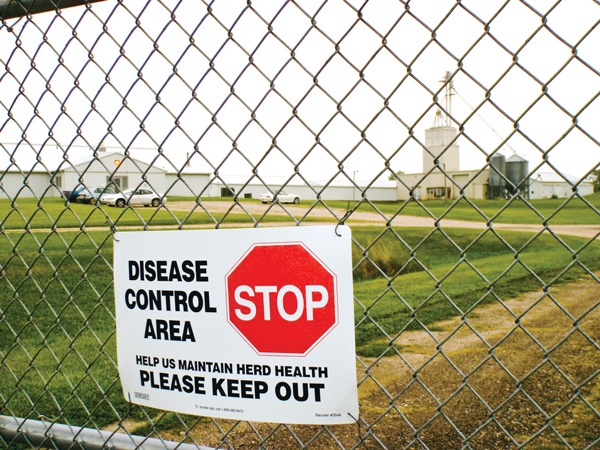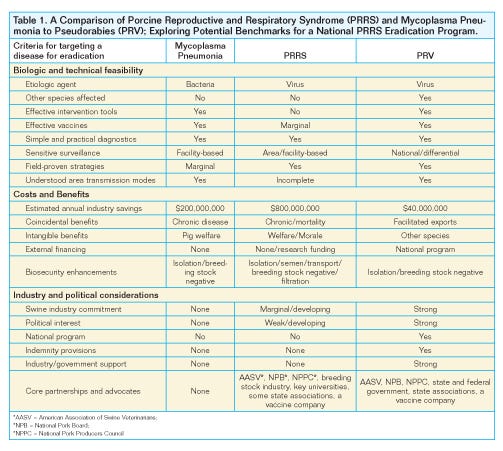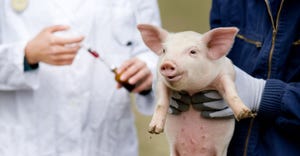Exploring the Science Behind Biosecurity and PRRS
As PRRS has moved through the industry at an alarming rate, the disease has increasingly forced the pork industry down a long path of ever-improving biosecurity efforts. It has motivated often difficult and costly economic decisions concerning bio­security measures, such as installing an air filtration system.
April 18, 2012

Recent estimates of the cost of porcine reproductive and respiratory syndrome (PRRS) virus to the U.S. swine industry have soared beyond $600 million “hard” dollars per year. When the more difficult-to-calculate, softer costs are added, the likely total is nearer to $1 billion annually.
As PRRS has moved through the industry at an alarming rate, the disease has increasingly forced the pork industry down a long path of ever-improving biosecurity efforts. It has motivated often difficult and costly economic decisions concerning biosecurity measures, such as installing an air filtration system.
There are health advantages to disease exclusion that pseudorabies and hog cholera eradication brought to the industry, facilitating the exports that continue to support pork producer revenues. Perhaps one day PRRS can be added to this list.
PRRS Biosecurity Roads
PRRS devastation has led the industry down many biosecurity roads since it was first recognized in the late 1980s. Research efforts and industry-contrived interventions have often provided incomplete results.
Although our knowledge of disease exclusion is much more robust today, we still struggle with both human failure and a lack of knowledge. The consequences of applying ineffective interventions has been unnecessary costs in equipment, facilities and human capital.
There were few significant breakthroughs in the early days shortly after 1992, when the virus was finally identified. It was an era of excessive downtime rules and over-application of older biosecurity standards that had origins in pseudorabies eradication and Transmissible gastroenteritis virus (TGE) management and elimination.
However, biosecurity efforts have steadily improved and we stand on the brink of successful, science-based disease exclusion.
Table 1 describes progress toward a national eradication program. Whether this becomes reality is for the pork industry to decide. When comparing PRRS and Mycoplasma pneumonia to pseudorabies (now eradicated from commercial pigs), it is apparent that there is prodigious potential value if successful.

The table doesn’t describe the difficulties or the costs involved to eliminate PRRS; this, along with the uncertainty of our biosecurity processes, has held us at bay. Therefore, the balance of this discussion will center on current biosecurity status and standards and future biosecurity necessities.
Proven Approach
A modern approach to biosecurity recognizes that it is composed of three overlapping components: bioexclusion, biomanagement and biocontainment. Bioexclusion is the combination of processes that producers employ to prevent a new disease agent entry. Biocontainment are those processes that prevent escape of disease agents to new pig populations, neighbors, etc. Biomanagement is the sum of the efforts to control and manage those disease agents already present.
Together, these efforts protect the farm from disease and assist in protecting the community of adjacent pig producers in a designated geographic area, encompassing neighbor to neighbor, community, county, state, or the nation in a situation of national eradication programs.
The modern hog farm is typically operated all-in, all-out (AIAO) by room, by barn and, in large operations, by site. This modern model is used by the vast majority in the industry. The AIAO approach reduces stress, disease exposure and mixing; improves welfare; and allows more efficient and efficacious use of vaccines and antibiotics. It is the backbone of biomanagement.
The modern North American pork production system is a sustainable and efficient model largely because of its emphasis on biosecurity, health improvement, advanced genetic productivity and a national effort to keep foreign animal diseases out.
Health improvement efforts and biosecurity have successfully eliminated, nearly eliminated or largely controlled many swine diseases. Lice, mange, roundworms, kidney worms, hook worms, atrophic rhinitis, pseudorabies, Classical Swine Fever (hog cholera), Actinobacillus pleuropneumonia (APP), Eperythrozoonosis (Mycoplasma suis), trichinosis, tuberculosis, nodular worms, thorny-headed worms, swine pox, TGE, vesicular stomatitis, swine brucellosis and numerous other disease agents no longer have significant impact on the industry.
Only two of these diseases were disposed of through government-sponsored and financed programs (hog cholera and pseudorabies). The others were eliminated or controlled by committed producers, high-health genetic suppliers, dedicated veterinarians and modern production methods. The current interest in PRRS control and elimination follows that historical
precedence.
Building a Biosecurity Plan
Biosecurity goals should be established as the first step of any biosecurity plan.
1. Risk factors. If the expectation is to keep out PRRS virus, then we must understand the risk factors involved, rank them in order of importance and estimate the cost to apply functional interventions at each critical control point.
2. Biosecurity strategies. Farm biosecurity strategies should be developed utilizing a Hazard Analysis Critical Control Point (HACCP) approach. Knowledge from scientifically applied field trial methodology, risk assessment, peer-reviewed publications and significant field experience should be heavily relied upon when establishing the critical control points (CCPs).
3. Critical control points. Extensive interviews and inputs from all farm staff should be included in the early stages of HACCP. Without participation of farm employees, many CCPs will be overlooked. Only when CCPs are identified can intervention strategies be developed. Only evidence-based intervention strategies that have demonstrable usefulness in the field are applicable.
4. Risk assessment program. Use of the American Association of Swine Veterinarians’ (AASV) Production Animal Disease Risk Assessment Program (PADRAP), which was initiated in 2006, is the ideal method for benchmarking risk factors associated with PRRS breaks. This is currently the only standardized biosecurity risk assessment available to producers and veterinarians. The risk assessment allows us to compare and allocate rankings to risk factors that appear to be associated with PRRS outbreaks to negative herds under similar conditions that remain negative over time. It allows us to scientifically make decisions based on a true ranking of risk factors and helps with biosecurity asset (dollar) allocation.
Biosecurity Procedures
The list of acceptable biosecurity practices is so lengthy that deciding where to spend biosecurity dollars is often difficult. A lack of scientific agreement adds to the confusion. Farm size, method of production and producer objectives also influence how biosecurity systems are implemented.
Bioexclusion has been the paramount effort in attempts to control PRRS. This article focuses on bioexclusion, but much more is needed in the area of general farm biocontainment.
As a rule, biocontainment is excluded because there is generally no economic consequence to the producer unless they are part of a large production system. The one exception is the boar stud, where extensive biosurveillance attempts to identify PRRS virus introduction before semen disseminates the virus to the customer sow farms.
Following is a partial list of pig biosecurity efforts and a brief discussion of relative importance and pitfalls:
1. Replacements. High-health, PRRS-free replacements, whether produced internally or externally, are critical to control and exclusion. Biosurveillance at the herd of origin and during the isolation/quarantine period are also essential. Testing and isolating replacement stock has become standard operating procedure. Genetic source stability (single sourcing) is generally practiced. A genetic source with a long history of PRRS freedom is most likely to remain free of the virus. PRRS-positive internal multiplication will make it very difficult to attain long-term stability due to virus change (evolution). Internal multiplication is a significant biomanagement challenge.
2. Semen source. A PRRS-free semen source is an essential component of bioexclusion as is the replacement source. Internal studs should be considered a part of biomanagement. Even so, it is most desirable that they not have active virus in the semen as it will negatively affect productivity and potentially keep the virus active, thus promoting virus change.
3. Transportation. Pig transportation is one of the major weaknesses of our national biosecurity effort. The larger production systems have taken advantage of new trailer designs, and major trailer manufacturers of pig transport equipment know how to produce a biosecure trailer. The drawback is added costs.
Thermal-Assisted Drying and Decontamination (TADD), BioDry and Trailer Baker facilities have become standard for many larger production companies. The ability of drying or applying heat treatment to inactivate PRRS virus and many other pathogens is well documented. The debate over how to manage the driver and loading/unloading process persists. A logical way to load into a nearly sterile trailer may be to keep the driver in the cab and consider the trailer a part of the farm once it connects to the loadout, allowing farm staff to load and unload.
Experience with drivers indicates that they are a greater risk of tracking PRRS virus compared to the trailer that has been properly cleaned, disinfected and dried or heated. One of the least-scrutinized and high-risk procedures performed on a pig farm is the management of cull transport. If external/independent haulers are involved, control of the bioexclusion risk is difficult.
4. Personnel. People movement is one of the most difficult risk factors to control. In a community, the number of indirect contacts between farm personnel and people or objects that potentially could be contaminated with PRRS virus is unequivocal.
For example, the feed truck and the feed are unlikely sources of virus introduction, but the driver could be a high risk if delivering feed to multiple farms, fueling and stopping for lunch, potentially contacting many sources of virus daily. This is an issue especially if the driver enters any part of the farm, including the office pass-through portal or the “dirty” zone outside the shower entry. Place a drop box for invoices at the farm entrance to avoid any contact with feed truck operators.
The local convenience market or any other store is likely to be contaminated from time to time in pig-dense communities. This raises the issue of shower-in, shower-out facilities, compared to the Danish shoe/boot/coverall exchange concept. Showers, when properly utilized and maintained, are great bioexclusion barriers against many disease agents, especially bacteria, and many viruses including PRRS. There is little question that breeding farms of any size should employ a shower-in, shower-out system.
Off-site commercial finishing operations may be another matter, and they are often well-suited to the Danish model. This is partly due to the all-in, all-out procedures generally employed and the lower economic impact of PRRS on finishing pigs compared to nurseries and breeding farms. Wean-to-finish barns and off-site nurseries may benefit from showers vs. changing boots and outerwear in a Danish entry approach.
The use of ultraviolet light alone is a non-viable bioexclusion barrier due to the time needed and unlikely exposure to all contamination on people or supplies. Likewise, dependency on boot bath disinfectant barriers at the entrance of a growing pig site utilized as the primary bioexclusion procedure is of no value regardless of effort because they become immediately contaminated and inactivated by manure and other organic material.
The value of downtime rules is dependent upon the training and commitment of people entering farms. Generally, for diligent personnel or visitors who observe bioexclusion protocols, one night away from pigs with a shower entry is satisfactory in commercial production for protection against PRRS virus and other pathogens.
Usually, farm staff who enter the farm daily pose as great a risk as visitors because of the indirect contacts noted above. Farm visitors should normally be prohibited, except those essential to the operation for veterinary service, repairs and maintenance. They should always arrive in a clean vehicle inside and out.
Because of the financial commitment, the breeding stock industry will continue to maintain much longer downtime rules that are not based on disease or science, but rather on common sense.
Visitors from a foreign country with an animal disease risk are required to be in the United States for five days before entering a farm. Most production companies require 10 days minimum. Never allow foreign visitors to bring food into a pig site.
5. Sow filtration. Over the past few years, many sow farms have been filtered. In pig-dense areas, where recurrent PRRS outbreaks are common, this strategy has been successful for those who implement a total biosecurity effort. The track record isn’t perfect, but it is apparent that filtered farms have significantly fewer PRRS breaks compared to non-filtered farms in the same geographic, high-risk area. The expense is significant, but the payback quickly yields a positive return on investment by greatly reducing or eliminating the frequency of PRRS breaks.
6. Barriers. Covered, bird-proof, load-out structures and bird-proof confinement buildings have long been a standard bioexclusion barrier. Although birds, rodents and other wild or domestic animals are not biologically a part of the PRRS experience, they can act as mechanical movers of many pig pathogens, including PRRS. Birds can be especially effective at moving contamination long distances. This was apparent in the days of an annual spread of TGE over the winter months when migrating birds competed with pig transport as the greatest danger for new disease introduction.
Our concern with insects and the installation of insect barriers failed us. It is generally accepted that they pose no threat for distant spread of PRRS.
7. Water supply. Any water supply that is drawn from a surface reservoir or shallow well can be a significant health risk. PRRS virus likes cold, wet conditions, and its survival in water is thought to be 10-14 days. Although there have been few reports of PRRS outbreaks associated with water supply, it represents a risk if there are PRRS-positive growing pigs in the area. On-farm water purification systems are difficult to manage and often pose a health risk to the pigs when they malfunction or are not properly maintained or designed.
8. Biomanagement. The term “internal biosecurity” is somewhat obsolete. Biomanagement is the more robust way to control PRRS and other disease agents already present within the farm or system. Biomanagement processes include all-in, all-out, cleaning and disinfectants, vaccines, people trafficking, hand wash stations, boot disinfectant stations, pig fostering control, antibiotic usage, needles-syringes-equipment management, product rotation and a host of other processes done within a farm to reduce disease burden.
Unfortunately, these procedures do little to prevent PRRS breaks because all pigs either die or recover from PRRS and are no longer a risk after a period of time. But the virus can persist for 180 days in some pigs. The addition of new breeding stock into stand-alone breeding sites aids persistence similar to continuous-flow sites. This knowledge has led us to use farm closure as a highly effective method to shorten and reduce the severity of outbreaks and as the first step of an elimination strategy in breed-to-wean sites.
Although farms that get the biomanagement done right have fewer breaks, this is believed to be only a marker indicating that they are also diligent about bioexclusion of the virus.
9. Security. A pig production site does not have biosecurity unless there is security. Thieves and other unwanted intruders often visit more than one location in a night of activity. There have been many reports over the years of PRRS activity after a robbery, especially when pigs were stolen. This is because the getaway truck had pigs from another source or was contaminated with virus from a previous excursion. Lockable main gates and building security with cameras are the best deterrents.
10. Waste haulers. Commercial and internal waste haul and management equipment and personnel can potentially move pathogens from site to site. They should never enter a farm unless it is empty of pigs. They should wash and disinfect all external surfaces of their equipment and observe all farm biosecurity rules. It is best to have biosecurity discussions during contract deliberations. Recently, there have been unconfirmed reports of swine dysentery introduction into farms from waste management equipment.
11. Bioexclusion. Farm supplies, drugs, vaccines, paper, computer supplies and many other items enter a farm weekly. These are minor bioexclusion risks, but become important if the delivery personnel are exposed to other farms. Supplies that are soiled or suspected of having been delivered to other farms should be rejected. Many farms use fumigation rooms for incoming supplies and equipment.
Biosecurity Philosophy
Tracking PRRS viruses has become possible with modern molecular techniques that allow us to compare the genetic codes of different virus isolates. These isolates can then be placed on a dendogram, which is like a family tree of virus relationships. The problem with interpretation is many of the “brothers, daughters, cousins, uncles and aunts, etc.” are missing. This leads to misinterpretation of virus origins and movements. Only when there are very close matches are we sure of a relationship.
Even so, viruses can be tracked, which helps us understand the effect of area and long-distant movements. It is evident that we suffer from both forms of virus introductions: area spread and long haul. We have tracked PRRS in every direction. The virus has no compass other than the one in the cab of the tractor or truck.
Sometimes viruses move hundreds of miles and become an area virus in a new location, where pigs lack immunity to this new isolate. Often, the virus quickly becomes an area virus circulating for months and even years in the new locale. These long-distant hops by the virus are a direct result of pig transportation. Pigs and trailers are a great opportunity for virus survival in the industry.
In the eventuality of a national elimination (eradication) program, management of growing pig destinations will be necessary as areas of the country become PRRS free. This is a big concern for those who move significant numbers of pigs to areas of feed availability and packer access. Unless a logical system is derived, this will remain a major impediment to PRRS control. Biocontainment will be a necessary step before any national program can be effective.
Area spread of the virus is dependent on the many factors discussed above. What appears to be airborne transmission, for lack of other explanations, is likely real in some cases.
However, this has become an excuse for some producers justifying not applying biosecurity safeguards. Jim McKean, DVM, Iowa State University, reminds us that during pseudorabies eradication days, raccoons were often blamed as the source of new infections, although we now believe this was a minor occurrence and other risk factors were to blame for most unexplained herd breaks.
Other countries have used filtration bioexclusion for years with apparent success. What is missing is a rational decision tree on when filtration should be employed.
Biocontainment is an opportunity to further reduce area spread and should be explored though scientific investigation. Technologies such as electrostatic dust removal, ultraviolet light exhaust filtration, odor reduction methodologies and other more experimental methods hold promise.
Likewise, vaccination of negative pigs 30-50 days before exposure to field virus will reduce viremia in those pigs. It is speculated that this biomanagement tool also reduces area spread by lowering the amount of virus escaping from a barn housing such pigs.
Also, use of specialized killed vaccines may offer additional protection in previously exposed breeding herds. Modified-live virus vaccines used in negative genetic replacements are a method that appears to reduce the severity of outbreaks in breeding herds.
Although vaccines have not provided the desired results for PRRS control, we are starting to recognize more logical ways to utilize them as biomanagement and perhaps biocontainment tools.
Users of live virus inoculation (LVI) also argue that this reduces the duration of virus activity and, thus, reduces area spread. Others argue that LVI only selects which viruses continue as area viruses. The jury is still out on many of these questions.
Keep the most in-depth pork production information available at your fingertips! Download our Blueprint app today.
You May Also Like



